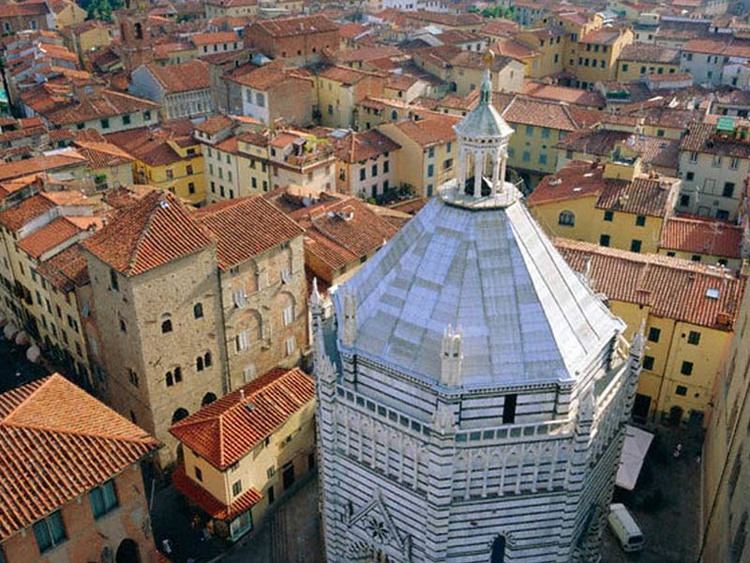Country Italy Province / Metropolitan city Pistoia (PT) Elevation 65 m (213 ft) Province Province of Pistoia | Region Tuscany Frazioni see list Demonym(s) Pistoiesi Local time Monday 6:01 PM | |
 | ||
Weather 17°C, Wind W at 10 km/h, 58% Humidity Points of interest Pistoia Cathedral, San Giovanni Fuoricivitas, San Bartolomeo in Pantano, Pistoia Sotterranea, Piazza della Sala | ||
Pistoia ([piˈstoːja]) is a city and comune in the Italian region of Tuscany, the capital of a province of the same name, located about 30 kilometres (19 mi) west and north of Florence and is crossed by the Ombrone Pistoiese, a tributary of the River Arno. It is a typical Italian medieval city, and it attracts many tourists, especially in the summer.
Contents
- Map of 51100 Pistoia Province of Pistoia Italy
- History
- Geography
- Architecture
- Piazza del Duomo
- Religious buildings
- Others
- Transportation
- Sister cities
- Events
- References
Map of 51100 Pistoia, Province of Pistoia, Italy
History
Pistoria (in Latin other possible spellings are Pistorium or Pistoriae) was a centre of Gallic, Ligurian and Etruscan settlements before becoming a Roman colony in the 6th century BC, along the important road Via Cassia: in 62 BC the demagogue Catiline and his fellow conspirators were slain nearby. From the 5th century the city was a bishopric, and during the Lombardic kingdom it was a royal city and had several privileges. Pistoia's most splendid age began in 1177 when it proclaimed itself a free commune: in the following years it became an important political centre, erecting walls and several public and religious buildings.
In 1254 the taking of Ghibelline Pistoia by Guelph Florence, was among the origins of the division of the Florentine Guelphs into "Black" and "White" factions. Pistoia remained a Florentine holding except for a brief period in the 14th century, when Castruccio Castracani captured it for Lucca, and was officially annexed to Florence in 1530. During the 14th century Ormanno Tedici was one of the Lords of the city. Dante mentioned in his Divina Commedia the free town of Pistoia as the home town of Vanni Fucci, who is encountered in Inferno tangled up in a knot of snakes while cursing God.
One of the most famous families of the city was that of the Rospigliosi, owners of agricultural estates and wool merchants; the Rospighliosi provided a pope in 1667 with Giulio Rospigliosi, who briefly reigned as Clement IX (1667–69), and gave several cardinals to the church.
In 1786 a famous Jansenist episcopal synod was convened in Pistoia.
According to one theory, Pistoia lent its name to the pistol, which started to be manufactured in Pistoia during the 16th century. But today, it is also notable for the extensive plant nurseries spreading around it. Consequently, Pistoia is also famous for its flower markets, as is the nearby Pescia.
Geography
Pistoia borders with the municipalities of Agliana, Alto Reno Terme (BO), Cantagallo (PO), Lizzano in Belvedere (BO), Marliana, Montale, Piteglio, Quarrata, Sambuca Pistoiese, San Marcello Pistoiese and Serravalle Pistoiese.
Architecture
Although not visited as much as other cities in Tuscany, mostly due to the city's industrial environs, Pistoia presents a well-preserved and charming medieval city inside the old walls.
Piazza del Duomo
The large Piazza del Duomo, dominated by the cathedral, is lined with other medieval buildings, such as the Palazzo del Comune and the Palazzo del Podestà: it is the setting (in July) of the Giostra dell'Orso ("Bear Joust"), when the best horsemen of the city's traditional quarters tilt with lances at a target held up by a dummy shaped like a bear.
The original Cathedral of San Zeno (5th century) burned down in 1108, but was rebuilt during the 12th century, and received incremental improvements until the 17th century. The façade has a prominent Romanesque style, while the interior received heavy Baroque additions which were removed during the 1960s. Its outstanding feature is the Altar of St James, an exemplar of the silversmith's craft begun in 1287 but not finished until the 15th century. Its various sections contain 628 figures, the total weighing nearly a ton. The Romanesque belfry, standing at some 67 metres (220 ft), was erected over an ancient Lombard tower.
In the square is also the 14th-century Baptistry, in Gothic style, with white and green striped marble revetment characteristic of the Tuscan Gothic.
The Palazzo dei Vescovi ("Bishops' Palace"), is characterized by a Gothic loggiato on the first floor. It is known from 1091, initially as a fortified noble residence. In the 12th century it received a more decorated appearance, with mullioned windows and frescoes, of which traces remain. It was later modified in the mid-12th century (when the St. James Chapel, mentioned by Dante Alighieri in the XXIV canto of his Inferno) and in the 13th century; to the latter restoration belongs the white marble-decorated staircase, one of the most ancient examples in Italy in civil architecture. In the 14th century, the Chapel of St. Nicholas was decorated with stories of the namesake saint and other martyrs.
The Tower of Catilina is from the High Middle Ages, and stands 30 metres (98 ft) high.
Religious buildings
Others
Transportation
The railway station is located on the Viareggio–Florence railway and it is at the southern end of the Porrettana railway, the original line between Florence and Bologna.
Sister cities
Pistoia is twinned with:
